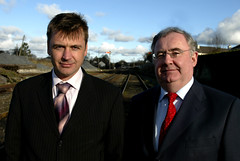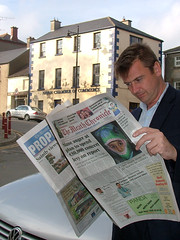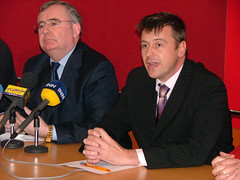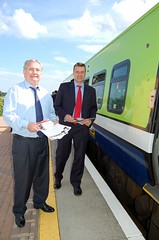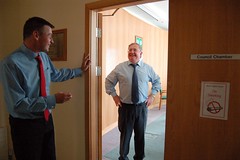Monday, March 29, 2010
Littering Problem gets worse
The instance of illegal dumping seems if anything to have got worse over the last number of months. Apart from being disgusting, littering also brings more rodents into an area. Close to where I live in East Meath there is a small laneway know locally as “Graves Lane” or as “Blackberry lane or as “Bryanstown Lane.” The laneway has suffered illegal dumping problems for many years, but right now it is worse than at any time I can remember. Here are some pictures to illustrate the impact.

Household rubbish at the side of the road
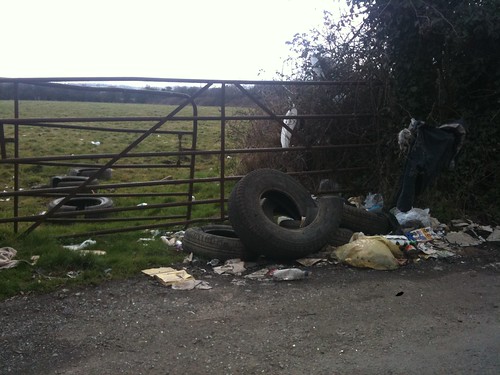
Tyres discarded at a gateway
Often these litterers will sit down at home before hand and remove any identifiable markings from the litter, so that it can’t be traced back to them. They will then load up the car, drive to their selected spot, and discard their rubbish at the side of the road. Their defence is along the lines that they can’t afford to pay the bin charges because of their own economic situation. However, the law is the law and this is no excuse.
And while there are calculated litterers such as those above, there are other grades of litterer too. For instance, why do many smokers still think it’s ok to dump cigarette butts and packets on the street? Why do some drivers just throw their empty tumbler out the window? Such littering has been happening regardless of the economic situation.
From what I can see if a laneway is out of the way and not many people use it then it is more prone to littering. That’s certainly the case with the particular location illustrated above. Also, the laneway is full of potholes. The fact that the council has left the lane surface disintegrate has added to the general air of neglect about it.
Over time, areas such as the one above get a reputation for littering. If an area is particularly bad then at some stage the council will come and clear it up. That often can provide a “justification” in the mind of the litterer, in that they know that the litter will eventually be taken away. They see it like a bring-bank for rubbish.
Up to know the Council has been quite good about keeping the situation under control. However, Council staff are suffering from an increase in workload and a cutback in funding. So, there are limited cleaning resources to go around. The lack of council action is often made up for by the generosity of our fellow citizens. I’ve met many local residents who take it upon themselves to pick up litter from roads and pathways that are often quite some distance from their houses. These civic-minded people are often all that is stopping an area deteriorating into a littering eyesore.
But these people are also fighting a losing battle. Without action the littering problem is likely to get worse here and elsewhere. This will continue to go on until there is a real fear of getting caught. Many litterers think that the council will never prosecute. That’s where they are wrong. They do prosecute, and they have now instigated a policy of “Name and Shame” on their website – see here
But a question that needs to be asked whether sufficient prosecutions are being made. A problem is that quite often it’s difficult to get sufficient evidence to make a successful prosecution. If you see someone dumping then your word alone is not enough. You need a corroborating witness. Alternatively, you need some photographic evidence.
I’d like to see the following four ideas implemented, which I believe would help tackle the problem:
• More CCTV cameras at key locations to enable more prosecutions to take place
• A bin charge waiver system introduced for those who genuinely cannot afford to pay
• More regulations limiting the amount of packaging that manufacturers can use in their products
• Better education in schools and on the airwaves about the impact of littering on our environment.

Household rubbish at the side of the road

Tyres discarded at a gateway
Often these litterers will sit down at home before hand and remove any identifiable markings from the litter, so that it can’t be traced back to them. They will then load up the car, drive to their selected spot, and discard their rubbish at the side of the road. Their defence is along the lines that they can’t afford to pay the bin charges because of their own economic situation. However, the law is the law and this is no excuse.
And while there are calculated litterers such as those above, there are other grades of litterer too. For instance, why do many smokers still think it’s ok to dump cigarette butts and packets on the street? Why do some drivers just throw their empty tumbler out the window? Such littering has been happening regardless of the economic situation.
From what I can see if a laneway is out of the way and not many people use it then it is more prone to littering. That’s certainly the case with the particular location illustrated above. Also, the laneway is full of potholes. The fact that the council has left the lane surface disintegrate has added to the general air of neglect about it.
Over time, areas such as the one above get a reputation for littering. If an area is particularly bad then at some stage the council will come and clear it up. That often can provide a “justification” in the mind of the litterer, in that they know that the litter will eventually be taken away. They see it like a bring-bank for rubbish.
Up to know the Council has been quite good about keeping the situation under control. However, Council staff are suffering from an increase in workload and a cutback in funding. So, there are limited cleaning resources to go around. The lack of council action is often made up for by the generosity of our fellow citizens. I’ve met many local residents who take it upon themselves to pick up litter from roads and pathways that are often quite some distance from their houses. These civic-minded people are often all that is stopping an area deteriorating into a littering eyesore.
But these people are also fighting a losing battle. Without action the littering problem is likely to get worse here and elsewhere. This will continue to go on until there is a real fear of getting caught. Many litterers think that the council will never prosecute. That’s where they are wrong. They do prosecute, and they have now instigated a policy of “Name and Shame” on their website – see here
But a question that needs to be asked whether sufficient prosecutions are being made. A problem is that quite often it’s difficult to get sufficient evidence to make a successful prosecution. If you see someone dumping then your word alone is not enough. You need a corroborating witness. Alternatively, you need some photographic evidence.
I’d like to see the following four ideas implemented, which I believe would help tackle the problem:
• More CCTV cameras at key locations to enable more prosecutions to take place
• A bin charge waiver system introduced for those who genuinely cannot afford to pay
• More regulations limiting the amount of packaging that manufacturers can use in their products
• Better education in schools and on the airwaves about the impact of littering on our environment.
Sunday, March 21, 2010
IT needs to be put at the heart of the Health Sector
My article below appeared in today's Sunday Times
The recent disclosure that GP referral letters are often left unopened in hospitals is inexcusable in the 21st Century. It raises the question of why we still organise our referral system in this out-of-date manner.
A review carried out in Tallaght discovered that a typical GP referral goes through 20 stages before it results in a consultation for the patient. The patient is seen by the GP, who decides that an appointment with a consultant is necessary. The GP informs the practice secretary, who writes a letter to the consultant. Once received by the consultant, the letter is (normally) opened and a date found in the consultant’s diary. An appointment letter is then sent out, suggesting a date and time for the patient’s consultation. Of course, if the suggested date does not suit the patient then they must ring up the consultant and seek a different date, adding more steps to the process.
Under this current process it can take weeks before a consultation date is agreed on. Meanwhile, the patient gets more concerned about their condition, or worse, they get sicker. The system needs to be redesigned, availing of modern technology when doing so. I can check myself on to a flight from Miami to Lima from the comfort of my office in Meath. Why can’t I book an appointment with my hospital consultant online?
That’s what the UK’s National Health Service did with their GP referral system, as part of their Better Care, Without Delay initiative. I worked as a management consultant within the health care system during its introduction in 2002. I saw at first-hand how the system was changed from focusing on the health care professional to focusing on the patient.
The initiative has completely changed the referral process. A patient still goes to their GP, but now if it’s felt that a consultation is needed, the GP enters this on the computer, which then prints out a password on a sheet of paper. The GP passes this to the patient. When the patient gets home they log on to the NHS website, enter the password and are directed to the consultant’s online diary, where they select a time and date that is convenient to them. So, within 12 hours of seeing their GP they have a confirmed appointment with a consultant. No more weeks of waiting in worry. For those who don’t have a PC there is a helpline appointment system.
Other countries have also embraced IT systems in their health service. For a decade now the Danes have stored their health care records electronically. Studies show that their system is the most efficient in the world, saving GPs an average of 50 minutes a day and saving the system €100million a year. They have even brought innovation into the home of the patient. By providing patients with their own electronic pulse readers, software and some training, patients can take their own weekly readings at home and send these via the internet directly into their online patient record. Frail patients, or those with limited mobility, can complete their regular check-ups without having to leave their own home.
I’m glad to see that some Dublin hospitals are starting to pilot similar home testing systems here. It’s easy to do, quick to implement and simple to understand. Patients can be seen sooner and their condition treated sooner.
But it’s not just in the health service where IT needs to be put to more use. In a report published in February, Kathleen O’Toole, Chief Inspector of the Garda Inspectorate, called for more investment to plug serious gaps in Garda technology. Computer aided dispatch systems and resource information systems have been used by most police agencies in Europe and North America for decades – yet we still don’t have them here.
There are other areas, too where technology should be considered. Next year’s census will require thousands of surveyors to call to homes across the country. Often several visits are needed to a house, because the owners are away. Why not look at the potential for people to return their census information online? That would cut out the need for someone to call and cut out the need for subsequent data coding.
We do have some positive examples of how the internet is being put to good use. Engineers Ireland is using the internet to broadcast online maths tuition on Saturday mornings to leaving cert students. They say that by webcasting these grinds they can help maths students in a time-efficient manner.
Technology is all around us. Where possible we need to use it to reduce our costs and free up staff to carry out other tasks. Other countries have embraced IT across a range of public services, so we don’t even have to invent; we can just copy.
The recent disclosure that GP referral letters are often left unopened in hospitals is inexcusable in the 21st Century. It raises the question of why we still organise our referral system in this out-of-date manner.
A review carried out in Tallaght discovered that a typical GP referral goes through 20 stages before it results in a consultation for the patient. The patient is seen by the GP, who decides that an appointment with a consultant is necessary. The GP informs the practice secretary, who writes a letter to the consultant. Once received by the consultant, the letter is (normally) opened and a date found in the consultant’s diary. An appointment letter is then sent out, suggesting a date and time for the patient’s consultation. Of course, if the suggested date does not suit the patient then they must ring up the consultant and seek a different date, adding more steps to the process.
Under this current process it can take weeks before a consultation date is agreed on. Meanwhile, the patient gets more concerned about their condition, or worse, they get sicker. The system needs to be redesigned, availing of modern technology when doing so. I can check myself on to a flight from Miami to Lima from the comfort of my office in Meath. Why can’t I book an appointment with my hospital consultant online?
That’s what the UK’s National Health Service did with their GP referral system, as part of their Better Care, Without Delay initiative. I worked as a management consultant within the health care system during its introduction in 2002. I saw at first-hand how the system was changed from focusing on the health care professional to focusing on the patient.
The initiative has completely changed the referral process. A patient still goes to their GP, but now if it’s felt that a consultation is needed, the GP enters this on the computer, which then prints out a password on a sheet of paper. The GP passes this to the patient. When the patient gets home they log on to the NHS website, enter the password and are directed to the consultant’s online diary, where they select a time and date that is convenient to them. So, within 12 hours of seeing their GP they have a confirmed appointment with a consultant. No more weeks of waiting in worry. For those who don’t have a PC there is a helpline appointment system.
Other countries have also embraced IT systems in their health service. For a decade now the Danes have stored their health care records electronically. Studies show that their system is the most efficient in the world, saving GPs an average of 50 minutes a day and saving the system €100million a year. They have even brought innovation into the home of the patient. By providing patients with their own electronic pulse readers, software and some training, patients can take their own weekly readings at home and send these via the internet directly into their online patient record. Frail patients, or those with limited mobility, can complete their regular check-ups without having to leave their own home.
I’m glad to see that some Dublin hospitals are starting to pilot similar home testing systems here. It’s easy to do, quick to implement and simple to understand. Patients can be seen sooner and their condition treated sooner.
But it’s not just in the health service where IT needs to be put to more use. In a report published in February, Kathleen O’Toole, Chief Inspector of the Garda Inspectorate, called for more investment to plug serious gaps in Garda technology. Computer aided dispatch systems and resource information systems have been used by most police agencies in Europe and North America for decades – yet we still don’t have them here.
There are other areas, too where technology should be considered. Next year’s census will require thousands of surveyors to call to homes across the country. Often several visits are needed to a house, because the owners are away. Why not look at the potential for people to return their census information online? That would cut out the need for someone to call and cut out the need for subsequent data coding.
We do have some positive examples of how the internet is being put to good use. Engineers Ireland is using the internet to broadcast online maths tuition on Saturday mornings to leaving cert students. They say that by webcasting these grinds they can help maths students in a time-efficient manner.
Technology is all around us. Where possible we need to use it to reduce our costs and free up staff to carry out other tasks. Other countries have embraced IT across a range of public services, so we don’t even have to invent; we can just copy.
Sunday, March 14, 2010
Innovation Taskforce suggests the way forward
The launch of the Taskforce on Innovation report this week provided a roadmap for how Ireland needs to refocus in certain areas if we are to create jobs for the future. The taskforce recommends faster broadband speeds, which we all agree with, but it also suggested other measures which may not be universally supported.
For instance, the report is absolute in its belief that Irish students must be better trained in Maths. It calls for extra points for Maths students at leaving cert level.
This concurs with a recent report by Engineers Ireland on the need to improve the quality of teaching of Maths in Schools and the need to increase the number of students taking maths. I had a meeting a week ago with Engineers Ireland to discuss this issue. I was a bit surprised to learn that there are as many students taking geography to higher level as there are Maths, Applied Maths and science combined. Now of course we need geographers – we have significant mining interests, planning issues and climate change worries to concern ourselves with, but in relation to innovation, creation of new jobs etc, we need to make sure that we have a sufficient number of maths and science graduates as well.
The report lists 18 proposals for how we can improve the quality and quantity of Maths graduate. I mentioned one in the Seanad this week – banning calculators at junior cert level. The purpose of this would be to try to increase the ability of students in the area of mental arithmetic. There are other ideas worth supporting as well. Fighting our way out of this recession and creating new jobs will be easier if we have a higher number of well-qualified maths and science graduates on our team.
Locally, I attended new branch meetings in the Slane electoral area and in the Navan electoral area. It’s part of our work to expand the party within Meath and to deepen the links between the party and local residents.
The Bru na Boinne branch will be covering that part of the Slane electoral area which remains in Meath East. Up to now this area was covered by the Jimmy Tully branch. This branch will continue to represent members in the East Meath areas of Laytown, Bettystown, Mornington and Julianstown.
Our new Bru na Boinne branch will be open to members from Stamullen, Duleek, Donore, Bellewstown, Slane and the townlands around these places. Our first meeting was in Dalys, in Donore, and it was attended by members from across the area. One of our first actions was to elect a chair – this position went to local resident James Bell. The main focus of the branch in the short term will be to get new members into the branch, thus providing input into the party from the ground up.
Later on in the week I attended the inaugural meeting of another branch. This time the meeting was in O’Connell’s pub on Skryne Hill. It is not for nothing that this pub was named one of the six best Irish pubs in the Sunday Times a couple of years ago. It’s very atmospheric and set in beautiful surrounds. The branch (which has the working title of “The Tara Valley branch” will cover the areas of Kentstown, Rathfeigh, Skryne, Cushenstown, Wilkinstown and Kilberry – all of those parts of the Navan electoral area that are in the Meath East constituency.
Both branches and indeed all other branches are looking for new members on a continual basis and if anyone would like some information then give me a ring at the office.
For instance, the report is absolute in its belief that Irish students must be better trained in Maths. It calls for extra points for Maths students at leaving cert level.
This concurs with a recent report by Engineers Ireland on the need to improve the quality of teaching of Maths in Schools and the need to increase the number of students taking maths. I had a meeting a week ago with Engineers Ireland to discuss this issue. I was a bit surprised to learn that there are as many students taking geography to higher level as there are Maths, Applied Maths and science combined. Now of course we need geographers – we have significant mining interests, planning issues and climate change worries to concern ourselves with, but in relation to innovation, creation of new jobs etc, we need to make sure that we have a sufficient number of maths and science graduates as well.
The report lists 18 proposals for how we can improve the quality and quantity of Maths graduate. I mentioned one in the Seanad this week – banning calculators at junior cert level. The purpose of this would be to try to increase the ability of students in the area of mental arithmetic. There are other ideas worth supporting as well. Fighting our way out of this recession and creating new jobs will be easier if we have a higher number of well-qualified maths and science graduates on our team.
Locally, I attended new branch meetings in the Slane electoral area and in the Navan electoral area. It’s part of our work to expand the party within Meath and to deepen the links between the party and local residents.
The Bru na Boinne branch will be covering that part of the Slane electoral area which remains in Meath East. Up to now this area was covered by the Jimmy Tully branch. This branch will continue to represent members in the East Meath areas of Laytown, Bettystown, Mornington and Julianstown.
Our new Bru na Boinne branch will be open to members from Stamullen, Duleek, Donore, Bellewstown, Slane and the townlands around these places. Our first meeting was in Dalys, in Donore, and it was attended by members from across the area. One of our first actions was to elect a chair – this position went to local resident James Bell. The main focus of the branch in the short term will be to get new members into the branch, thus providing input into the party from the ground up.
Later on in the week I attended the inaugural meeting of another branch. This time the meeting was in O’Connell’s pub on Skryne Hill. It is not for nothing that this pub was named one of the six best Irish pubs in the Sunday Times a couple of years ago. It’s very atmospheric and set in beautiful surrounds. The branch (which has the working title of “The Tara Valley branch” will cover the areas of Kentstown, Rathfeigh, Skryne, Cushenstown, Wilkinstown and Kilberry – all of those parts of the Navan electoral area that are in the Meath East constituency.
Both branches and indeed all other branches are looking for new members on a continual basis and if anyone would like some information then give me a ring at the office.
Sunday, March 07, 2010
Starting Our Report on Overseas Aid
I launched our online survey into Overseas Aid at the beginning of the week. The survey is part of a study my office is undertaking this year into the Irish Overseas Aid programme.
The study will be looking at the Irish Aid program and the work will involve desk-research, consultation with relevant bodies, case studies and gathering of opinion and views about the aid programme itself.
The research for the report is now underway, and I am being assisted in the work by my intern, Sam. During the course of the study we will be carrying out reviews of what other countries are doing. We will be speaking to people within the industry (including non-governmental organisations such as Trocaire, Bothar, Concern etc.). We will also be talking to representatives of groups and countries that have received aid, including ambassadors and representatives of local groups. The analysis will focus on our nine priority countries, although we will also include some other case studies, including one from Bolivia and one from Niger.
Part of the study will also examine Irish attitudes to aid. The survey asks a range of questions to members of the public on their perceptions of the Irish aid programme.
The survey is quite short and takes only two or three minutes to complete. It can be found here.
To avoid any bias of self-selection we will also be carrying out face-to-face interviews on the street as well as telephone calls to random people. The idea in any of these surveys to get as wide s a cross-section of opinions as possible. That way the results are reflective of society as a whole, and not of any one particular group within society.
Also, we will be carrying out a separate survey of politicians. A survey form will be send to all County and City councillors in the country seeking their views on the aid programme.
There’s quite a lot of work involved in a study such as this and we reckon it will be another six months or so before we complete the survey. Our aim is to get the report finished and released before the end of this year.
On Tuesday I attended a Careers Advice night in Greenhills School in Drogheda. The event was arranged for all schools across the Drogheda area, so it catered not just for Louth students, but Meath students also. I was talking from some students from Mornington and also from just outside Slane.
The event was well attended and I managed to have a chat not just with the students, but with a few of the teachers as well. My former Physics teacher, Joe Sweeney, was there and I had a quick word with him. He looks like he hasn’t aged a day in the last 25 years!
The students were very interested in how one becomes a Senator. The most common question was “What qualification do you need”. Of course, when they heard the answer (“None”) their eyes lit up and they got very interested. I explained to them the process of having to get elected, and that if you don’t do your job well then you lose it. I also advised them to get some qualifications first, so they would have something to fall back on if politics didn’t work out.
Cllr Sirena Campbell was also in attendance. I hadn’t seen her since the election count last June. It was nice to catch up with her. She seems to be settling in at this stage.
The latest Oireachtas video was launched this week, featuring yours truly. You can see it here.
Smartasses can stand down – I’ve already heard the jibes – YES, that is me running, it’s not a double, and NO, I am not being pursued by some out-of-shot disaffected branch member.
The study will be looking at the Irish Aid program and the work will involve desk-research, consultation with relevant bodies, case studies and gathering of opinion and views about the aid programme itself.
The research for the report is now underway, and I am being assisted in the work by my intern, Sam. During the course of the study we will be carrying out reviews of what other countries are doing. We will be speaking to people within the industry (including non-governmental organisations such as Trocaire, Bothar, Concern etc.). We will also be talking to representatives of groups and countries that have received aid, including ambassadors and representatives of local groups. The analysis will focus on our nine priority countries, although we will also include some other case studies, including one from Bolivia and one from Niger.
Part of the study will also examine Irish attitudes to aid. The survey asks a range of questions to members of the public on their perceptions of the Irish aid programme.
The survey is quite short and takes only two or three minutes to complete. It can be found here.
To avoid any bias of self-selection we will also be carrying out face-to-face interviews on the street as well as telephone calls to random people. The idea in any of these surveys to get as wide s a cross-section of opinions as possible. That way the results are reflective of society as a whole, and not of any one particular group within society.
Also, we will be carrying out a separate survey of politicians. A survey form will be send to all County and City councillors in the country seeking their views on the aid programme.
There’s quite a lot of work involved in a study such as this and we reckon it will be another six months or so before we complete the survey. Our aim is to get the report finished and released before the end of this year.
On Tuesday I attended a Careers Advice night in Greenhills School in Drogheda. The event was arranged for all schools across the Drogheda area, so it catered not just for Louth students, but Meath students also. I was talking from some students from Mornington and also from just outside Slane.
The event was well attended and I managed to have a chat not just with the students, but with a few of the teachers as well. My former Physics teacher, Joe Sweeney, was there and I had a quick word with him. He looks like he hasn’t aged a day in the last 25 years!
The students were very interested in how one becomes a Senator. The most common question was “What qualification do you need”. Of course, when they heard the answer (“None”) their eyes lit up and they got very interested. I explained to them the process of having to get elected, and that if you don’t do your job well then you lose it. I also advised them to get some qualifications first, so they would have something to fall back on if politics didn’t work out.
Cllr Sirena Campbell was also in attendance. I hadn’t seen her since the election count last June. It was nice to catch up with her. She seems to be settling in at this stage.
The latest Oireachtas video was launched this week, featuring yours truly. You can see it here.
Smartasses can stand down – I’ve already heard the jibes – YES, that is me running, it’s not a double, and NO, I am not being pursued by some out-of-shot disaffected branch member.

